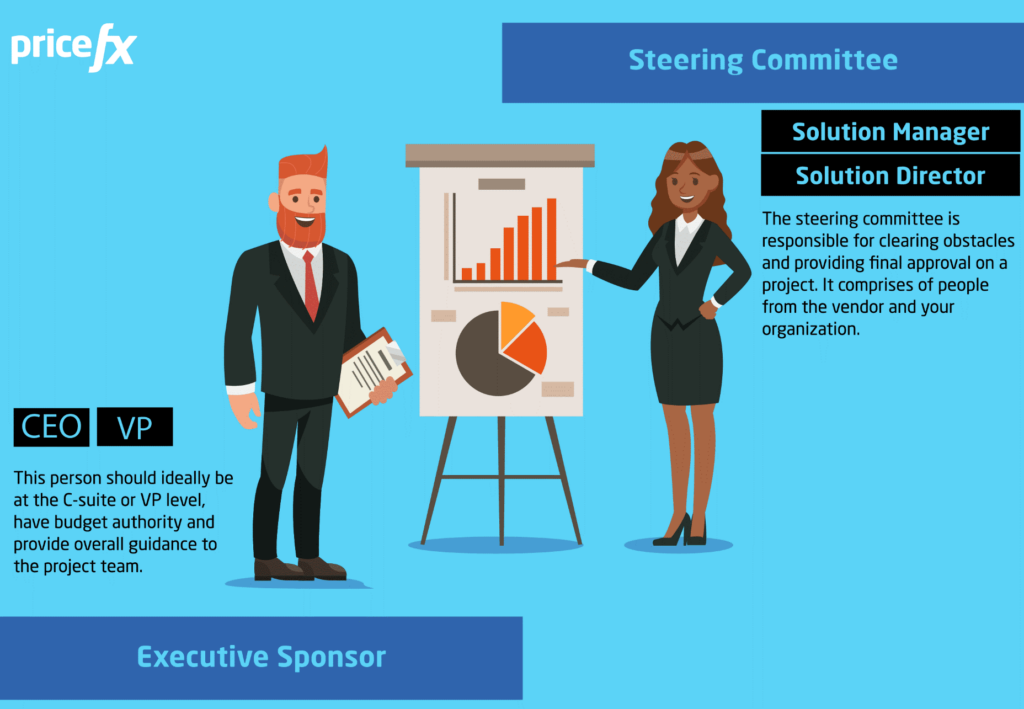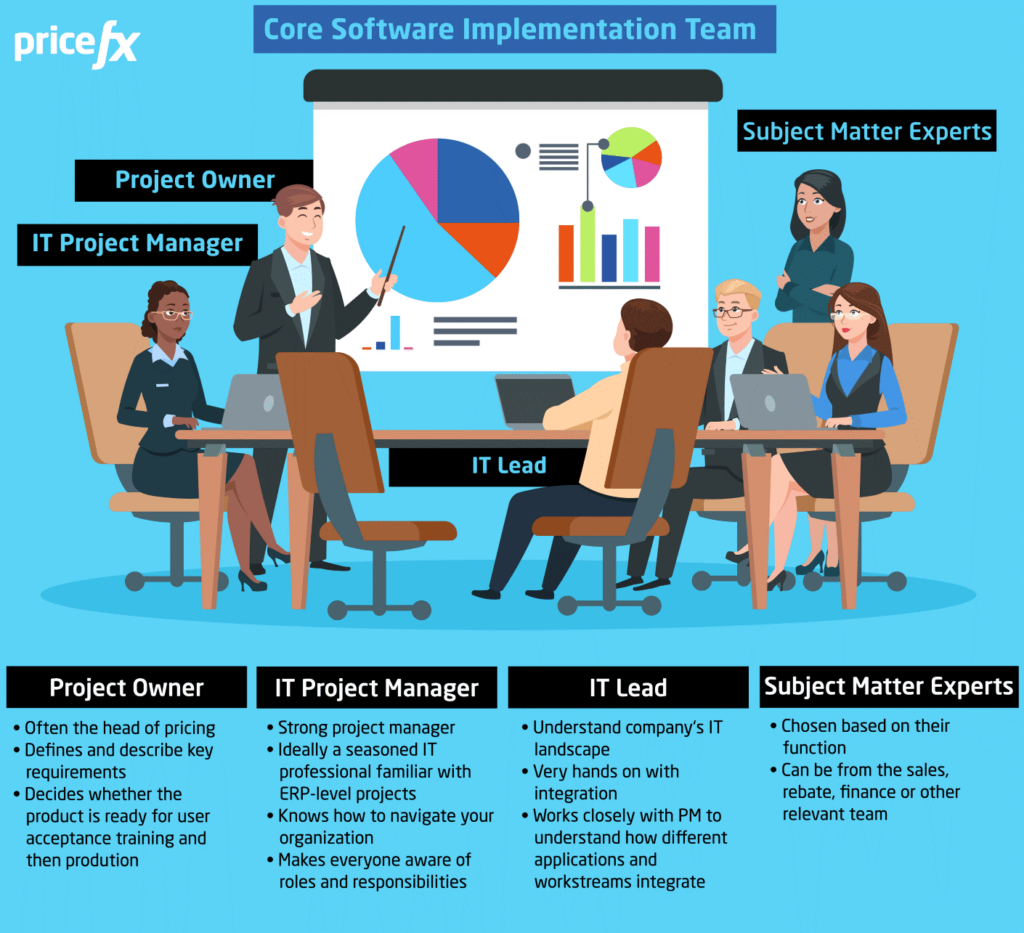Key Roles & Responsibilities You Need On A Software Project
October 19th, 2021 (Updated 03/10/2023) | 8 min. read
By Chris Keenan
The last thing you want to be doing is spending months building a pricing solution only to find that the people you need to be its users are resistant to change and are unwilling to use it. Something that your management team would certainly be displeased to discover.
At Pricefx, we’ve spent the last decade advising project leaders on the key internal resources they need to successfully complete a pricing implementation project. The roles and groups of people highlighted below are a necessity in any implementation project. Having multiple people from relevant departments builds consensus – a key to adoption after the project is finished. By reading this article, you’ll know which people you need, the roles they play and their responsibilities on your pricing software project. This way, you can reach out to them and start prepping for your project’s success.
Who Are the Stakeholders in a Software Project?
Steering Committee: The steering committee usually runs at a level above the individual project team. It’s their job to help resolve any issues at the individual project level by clearing obstacles and giving final approval on anything that may affect the organization past the project core team.
The steering committee will almost always include a VP or someone at the C level, depending on the size of the organization. When working with a software vendor, you’ll want someone who can provide a solution manager or director to help oversee the project on their side. For example, at Pricefx, we provide at least one of those roles.
You will want the people on your steering committee to be able to provide their insight and also have the power to make quick decisions.
Executive Sponsor: On the steering committee, you will have an executive sponsor. This person is needed because any digital transformation project requires a leader who can remove obstacles and provide resources and is dedicated to seeing the project be a success. This is typically someone at the VP or C level of an organization.
They have budget authority, the ability to navigate the organization, to distribute resources and to remove any blockers or impediments to the project. They, along with other members of the steering committee, are the ones who will make any difficult decisions that the project team wants to bring up to a more senior level for resolution.
This person is effectively the member of the steering committee who also provides the overall guidance and direction to the project team.
The executive sponsor must understand the value of pricing and put the weight and support of the organization behind the project. Depending on your organization, you can find this person in finance, sales, pricing or even the CEO.

Core Software Implementation Team: Next, you have the actual implementation team. They are the people that will work closely with your vendor’s team to deliver the end solution. If these roles are not filled, you will not be able to implement the software at all.
IT Project Manager: Once you have an executive sponsor on board, you will need a strong project manager (PM) – someone who can navigate the different areas of your organization to get things done on time and help to make sure project activities, tasks and people are coordinated.
Ideally, this person is a seasoned IT professional who is familiar with implementing ERP-level projects. This is because pricing implementation requires integration with other systems and a certain degree of change management. A project management professional will be able to navigate your company’s organization to make sure that your team is prepared.
The PM also makes sure each person is aware of their roles and responsibilities and can help manage the key elements of the project: time, budget and scope. Whatever implementation method you use, you will need someone whose focus will be on the project running smoothly and on schedule. Choosing the right person in your organization for this role is key as he or she will be one of the keys to success.
Project Owner/Lead: Another key role is a product owner. This person is often the head of pricing. They, along with his or her subject matter experts (SMEs), will define and describe the requirements. They’ll also prioritize the work to be done in each of the feature development sprints.
They control what the priorities to work on are, what is ready to be reviewed and estimated by the team, and what gets implemented first. At the end of the scheduled feature development sprints, they get to make the decision whether the product increment is ready to be released for user acceptance testing (UAT) and then for production.
For this role, you will want to have a person who understands what features are most valuable to the business and the trade-offs between competing priorities.
IT Lead: You will also need a strong IT lead who understands the company’s system landscape, the ERP system, the data and where it lives, and has a vision for how it will be sent to applications such as your source system or ERP, such as SAP, Oracle, JD Edwards or any other system.
Though they might have similar knowledge and ability as the project manager, the IT lead is the person who will be more hands on with the integration. The project manager will need to work closely with this individual to understand how different applications will work together to keep multiple workstreams on track.
Subject Matter Experts: The subject matter experts of any implementation project should be chosen based on the specific function or solution that is being implemented. For example, if you were to start with price setting, you would most likely want someone from the pricing team to supply feedback and relevant insights on how you do pricing today – so that processes can be implemented correctly by the vendor.
On the other hand, if you are developing a quoting solution, then you likely will need to pull in members of your sales team to describe how they quote your customers today. In the case of rebates, you will need someone from the pricing team to provide input on pricing, sales on the rebates being offered, and finance and accounting to understand how they accrue and pay out rebates.
As you can see, the people who make up your subject matter experts depend on the solution you’ll implement. Without them, you run the risk of building a solution that is unusable.

How Much Time Should Each Stakeholder Expect to Spend on a Software Project?
The SMEs that you add to your project depends on the solutions you will be implementing. This means that you might not need them throughout the project – which is good news for them and for the project as it will move faster by only expanding the team when absolutely needed.
However, when it’s their turn to support the project, each person should be ready to provide anywhere from 10 to 25 hours of their time per week.
This might seem like a lot of ask but you must remember pricing is one of the key levers you will need to increase sales and margins. The project lead and the vendor you choose need to be realistic about the time that’s needed so there is sufficient participation in requirements gathering and eventually testing.
Additionally, by having the time conversation upfront, we can all be transparent about responsibilities so that we plan out the work as well as we can around available resources and build in backups so that no one person acts as a bottleneck.
Getting by With a Little Help From a Partner
If you can easily list the people we’ve outlined above and the roles they’ll play in your implementation, then you’ll be ready to start reaching out to them in preparation for the project.
However, depending on how your organization is set up or where you are in your pricing journey, you might not have the core team resources or might need help further developing your pricing strategy. This is where an ecosystem of partners can help.
For example, at Pricefx, we have partners that are able to help with pricing strategy, data analysis and transformation, integration and change management. Our stable of experienced partners and digital transformation specialists can help you develop or re-imagine pricing strategies that support your long-term goals. If you think you need added support from an expert partner for your project, then head over here to find the partner(s) that’s right for you.
